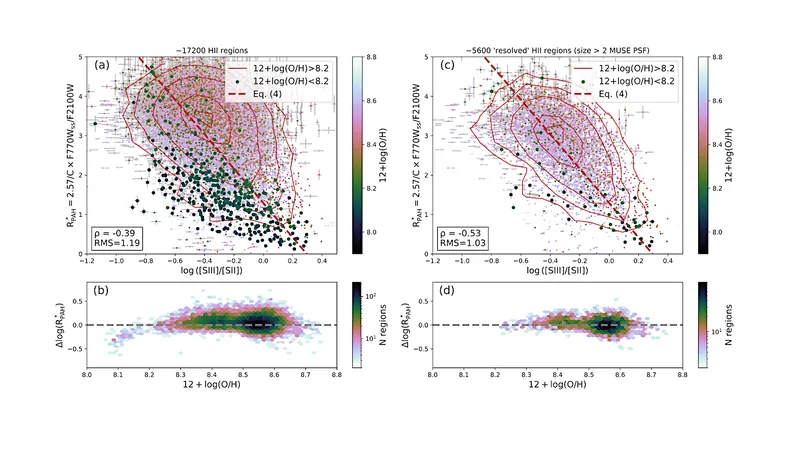
Unraveling the Cosmic Mystery: How Starlight Destroys Polycyclic Aromatic Hydrocarbons
2025-09-22
Author: Yu
The Cosmic Role of PAHs in the Universe
Polycyclic aromatic hydrocarbons (PAHs) are fascinating compounds found throughout the interstellar medium (ISM) of galaxies with Solar metallicity. These organic molecules are crucial players in the cosmos, significantly influencing how these regions heat and cool, and they even help process stellar radiation.
New Discoveries from JWST and MUSE
Recent observations using the powerful James Webb Space Telescope (JWST) and MUSE have revealed groundbreaking insights into the PAH fraction across 42 galaxies from the PHANGS survey. By examining more than 17,000 H II regions, which are areas of gas and newly formed stars, along with roughly 400 isolated supernova remnants (SNRs), researchers uncovered a startling trend: the PAH fraction is markedly lower in H II regions compared to diffuse ISM areas with similar metal content.
Ionization: The Silent Destroyer of PAHs
At higher metallicities (specifically, when 12+log(O/H) > 8.2), the data reveals a compelling anti-correlation between the PAH fraction in H II regions and the local ionization parameter. This suggests that the destruction of PAHs is intricately linked to the presence of ionized gas and the powerful UV radiation that comes from young, hot stars.
A Steep Decline in Metal-Poor Regions
As metallicity decreases, the PAH fraction plunges dramatically in both H II regions and the diffuse ISM. This trend indicates that forming PAHs becomes increasingly challenging in environments deficient in metals, signaling a significant shift in chemical processes in the cosmos.
Evidence of Selective Destruction
By isolating dust emission near supernova remnants, researchers found clear signs of selective PAH destruction. Although these effects are subtle and nearly indistinguishable at scales of around 50 parsecs, they reinforce the idea that ionizing radiation is a significant force behind the breakdown of PAHs within these stellar nurseries.
Implications for Galactic Evolution
The findings underscore that ionizing radiation, shaped by the metals present in a galaxy, is a driving factor in the abundance of PAHs across the universe. As galaxies evolve and their metallicity changes, so too will the dynamics of these cancer-causing organic molecules, reshaping our understanding of chemical interactions in space.
A New Frontier in Astrophysics
As our understanding of cosmic chemistry deepens, the implications of PAH dynamics may extend far beyond astronomy. They could play pivotal roles in astrobiology and astrochemistry, helping scientists explore the building blocks of life in the universe.



 Brasil (PT)
Brasil (PT)
 Canada (EN)
Canada (EN)
 Chile (ES)
Chile (ES)
 Česko (CS)
Česko (CS)
 대한민국 (KO)
대한민국 (KO)
 España (ES)
España (ES)
 France (FR)
France (FR)
 Hong Kong (EN)
Hong Kong (EN)
 Italia (IT)
Italia (IT)
 日本 (JA)
日本 (JA)
 Magyarország (HU)
Magyarország (HU)
 Norge (NO)
Norge (NO)
 Polska (PL)
Polska (PL)
 Schweiz (DE)
Schweiz (DE)
 Singapore (EN)
Singapore (EN)
 Sverige (SV)
Sverige (SV)
 Suomi (FI)
Suomi (FI)
 Türkiye (TR)
Türkiye (TR)
 الإمارات العربية المتحدة (AR)
الإمارات العربية المتحدة (AR)